

LOWER SCHOOL
students are academically engaged and socially empowered. Our goal is to build each child’s selfconfidence by laying a foundation of both academic and social skills. Lower school students are exposed to a wide variety of activities and topics that both enrich and enhance their experiences. Classroom teachers in the lower school provide students with opportunities to learn in ways that are intrinsically rewarding. Our academic program is challenging and differentiated to ensure that each child’s learning style and needs are met. Small class sizes allow teachers to develop a close, nurturing relationship with each student. Lower school teachers recognize and understand the individual needs of each child in addition to fostering a supportive, emotionally healthy, mindful classroom community.



OUR MISSION
Harbor cherishes childhood, cultivates wonder and inspires confident learners and leaders.
In the lower school we strive to create a joyful and emotionally nurturing environment where Harbor believes celebrating diversity
DIVERSITY STATEMENT
enriches the lives of everyone, and that embracing the essence of each individual makes us stronger as a school community. We honor different perspectives, cultures, ways of life, and the beliefs people bring when they walk through our doors. As a result, our students possess the moral and ethical foundation that prepares them to live with compassion and empathy in a global world.
LANGUAGE ARTS
The lower school English language arts program is based on the Reader’s and Writer’s Workshop model and draws heavily from the Teachers College Reading and Writing Project . Students consistently practice the skills, habits, and techniques necessary to become increasingly confident and successful readers and writers.
The ability to work in small groups to develop and expand deeper thinking about texts, as well as to read independently, are cornerstones of the Reader’s Workshop model. Throughout each grade, students read in partnerships, small groups, and independently to build a love and appreciation for reading. As readers, students become self-reflective while they learn to apply strategies that help them develop their fluency, comprehension, and both critical and analytical thinking. Knowing that reading and writing are closely aligned, we enjoy seeing our students apply what they learn as readers to their writing and what they learn as writers to their reading.
With so many different kinds of readers, even within one grade level, we want to ensure that no matter what the level, each child enjoys reading, learns more about the world from reading, and expands their interest in the kinds of books they may read. By understanding where each child is in their reading through oneon-one assessments, teacher observation and guidance, and parent input, we can support and challenge each child in becoming life-long lovers of literature.
In our writing program, the Writer’s Workshop approach is a process that encourages students to take ownership of their writing by making choices to effectively communicate with their audience. Our writers learn how to apply the techniques authors use, in addition to developing their own style and “writer’s voice.” When students write, they move through the different stages of the writing process by rehearsing, drafting, revising, editing, and publishing.



Lower School
MATH
We encourage and strengthen our students’ skills and foundations in mathematics using the Singapore Math program. In this program, students learn mathematical concepts as well as the algorithms to develop confidence in understanding numbers and computation skills. Singapore Math presents each math concept in three stages: 1) using hands-on objects, 2) using pictures, 3) using written symbols. The use of manipulatives and the practice of paper and pencil problem-solving complement each other. Teachers observe the children as they learn specific concepts, recognize the unique ways the children are solving math problems, and teach the appropriate strategies to build each student’s confidence and foundation in mathematics. Children practice and master these strategies before moving on to the next mathematical concept. The goal is to establish a deeper understanding of the meaning of numbers, how to compute, and how to solve math problems and equations.

Lower School

SOCIAL STUDIES
Social studies is designed for children to better understand their place in the
community and encourage them to expand their thinking, locally, regionally, domestically, and globally. We examine the experiences of people and cultures from the past and how they influence our present day, and we appreciate and celebrate the differences among us. Field trips play an important role in deepening this understanding and appreciating history.
SPEAKING AND LISTENING
Speaking and listening are essential components of the lower school program, as students become confident public speakers and open-minded listeners. Practice in public speaking and listening helps students become self-assured, poised speakers, as well as attentive and active listeners. Reinforcing these skills, students have many opportunities to present musical performances; project work; poetry; and even out-of-school, personal interests during our weekly All School Meetings. In a small class setting and community-wide performances, each child is supported and encouraged to speak publicly on a daily basis. By concentrating on thoughtful speaking and listening skills, students learn how to express themselves with confidence and learn about the world around them.

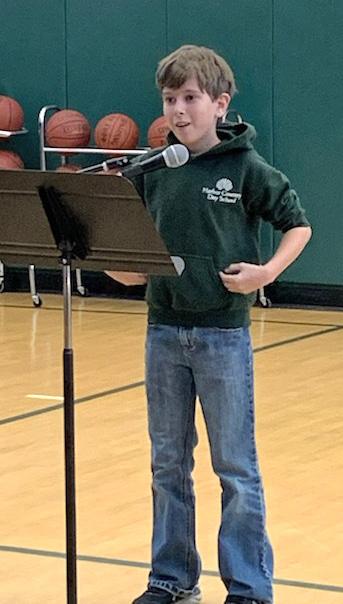
Lower School
ASSESSMENT METHODS
Assessment of students in lower school is ongoing and includes both conventional testing as well as authentic measurements of student learning. Assessment occurs regularly and provides teachers with many opportunities to help each child reach his/her full potential. In addition to written work, we incorporate hands-on projects throughout the year in all disciplines; these are assigned as individual and small-group projects. (Most group projects are completed during school hours.) In addition, teachers use observations throughout each day to assess how children work independently and in small groups. One-on-one conferences are also important assessment tools. In these conferences, students can set their own learning goals and both teacher and student can recognize and celebrate a student’s strengths.


Literacy
We use the Teachers College Reading and Writing Project’s pre- and post-assessments for our reading and writing units. Pre-assessments help teachers understand what students already know about upcoming topics. Postassessments allow students to show their understanding after a unit is completed.
Math
Singapore Math assessments are given at the end of a unit of study. Teachers routinely meet with students to discuss the work they are doing. These conferences help teachers learn more about their students’ thinking and approach to material so instruction can be differentiated, appropriately.
Lower School
ORGANIZATION
We believe that constructing a reliable and predictable set of study skills paves the way for independence and deeper learning, both of which are fundamental to building a foundation of strong academic skills. We encourage students to keep their desks, books, and folders organized. We also develop consistent homework, project, and classwork timelines to help students grow as confident learners who learn to self-advocate whenever they need help. We teach students how to manage their time wisely and pace all assignments appropriately. Our homework assignments are meaningful, designed explicitly to support the learning that happens in the classroom.



FIFTH GRADE “BRIDGE” YEAR
One unique quality of our lower school program is the fifth grade model, which is designed as a bridge to the upper school. Students have a “home base” teacher to support them as they transition between classes and stay organized with, among other things, their own cubby for their materials and personal belongings. Students assume responsibility for keeping track of their homework in planners and through Google Classroom. Students also join the upper school as advisees in the Advisory Program, which focuses on social and emotional learning, character development, and service learning. Advisory groups meet every morning for a daily check-in and once a week for a full period. In addition, the fifth grade joins the sixth grade in the fall on a two-night, three-day overnight trip to Frost Valley, as well as on the fifth and sixth grade interscholastic athletic teams.
FIRST GRADE LANGUAGE ARTS
In Reader’s Workshop, the students’ year begins with the reinforcement and refining of reading skills that they have learned the previous year. They work toward decoding (using strategies to figure out unknown vocabulary) and reading words. Students identify themselves as readers, learning and building the necessary reading habits to find meaning in texts and build comprehension.

Units of study for Reader’s Workshop include:
Building Good Reading Habits
Learning About the World:
Reading Nonfiction
Readers Have Big Jobs to Do (Fluency, Phonics, and Comprehension)
Meeting Characters and Learning Lessons: A Study of Story Elements
In Writer’s Workshop, first graders learn how to organize and write texts that stay on topic and include supporting details. We focus on helping students work toward becoming independent writers. Writing themes include opinion, information, and narrative writing, which foster higher-level thinking so students are able to synthesize, analyze, and critique their work.
Units of study for Writer’s Workshop include:
Small Moments:
Writing with Focus, Detail, and Dialogue
Nonfiction Chapter Books
Writing Reviews
From Scenes to Series
Handwriting practice takes place in short, 15-minute intervals with the use of academic language and modeling. This improves fine motor skills and literacy development, as well as letter formation and automaticity.
First Grade
FIRST GRADE MATH
First grade math focuses on teaching students various math strategies in order
to solve mathematical problems and equations. They also work on building and deepening their addition and subtraction facts to 100. Students visualize different ways to make the number “10,” which strengthens their mental math skills. They also read graphs, understand place value, and learn the basics of telling time and counting money. Children frequently work with manipulatives in order to give them a visual to support their understanding of the topic.


Units of study for Math include:
Whole Numbers and Place Value
Cardinal and Ordinal Numbers
Comparing and Ordering Numbers
Addition and Subtraction
Graphs
Shapes and Patterns
Multiplication
Division Time Money
Grade
FIRST GRADE SOCIAL STUDIES
We stress character development at an early age and our first grade Social Studies unit is the perfect place to incorporate this work while emphasizing empathy for others. Incorporating social-emotional development in the classroom, in which students become self-aware of their own emotions and develop strategies for dealing with them, aids in strengthening their relationships with peers and adults in addition to helping them focus on academics. Community, responsibilities, and citizenship are topics that we highlight. Children learn about the geography of the United States of America, pilgrims, and Native Americans, as well as holidays from around the world.


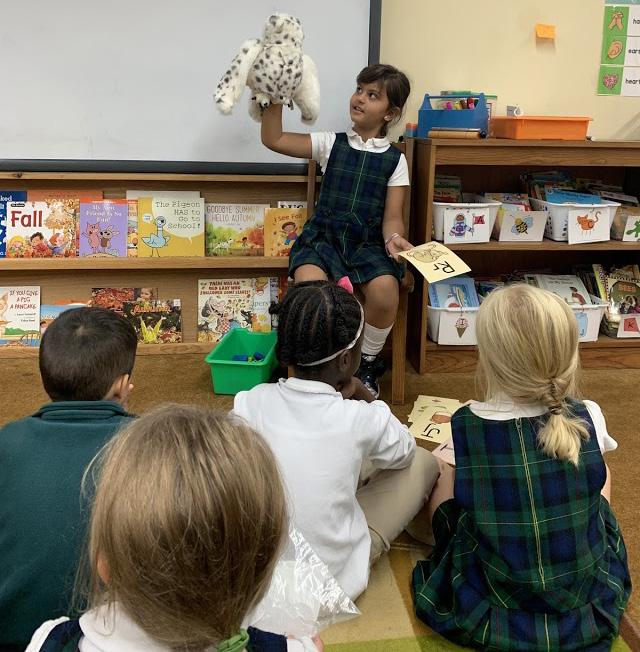
SECOND GRADE LANGUAGE ARTS
As mentioned above, the lower school English language arts program is based on the Reader’s and Writer’s Workshop model and draws heavily from the Teachers College Reading and Writing Project. Language arts focuses on developing and building each child’s confidence as a reader on an individual basis. We support, stretch, and challenge each one as they learn a variety of reading strategies including accuracy, oral fluency, and strengthening their reading comprehension. Using pictorial and textual evidence, students deepen their reading skills using both fiction and nonfiction texts as they begin to understand the difference between fiction and nonfiction. Time for reading for enjoyment is incorporated into each day. Students are writing on a daily basis, learning how the words they use can deepen the meaning of what they write. Teachers structure mini-lessons and work alongside children to develop their understanding and application of vowel sounds and vowel “teams” to strengthen their spelling. We also focus on prefixes, suffixes, and irregular spelling patterns, as well as mechanics and syntax.


Units of study for Reader’s Workshop include:
Building Good Reading Habits
Character Studies
Poetry
Author Studies
Nonfiction
Writing About Reading
Units of study for Writer’s Workshop include:
Small Moments
Fiction
Nonfiction
Poetry
Second Grade
SECOND GRADE MATH
Using the Singapore Math program, second grade math units continue
to broaden students’ mathematical foundation and expand their understanding. Students also investigate concepts that aid them in their everyday lives such as measurement, fractions, and telling time.
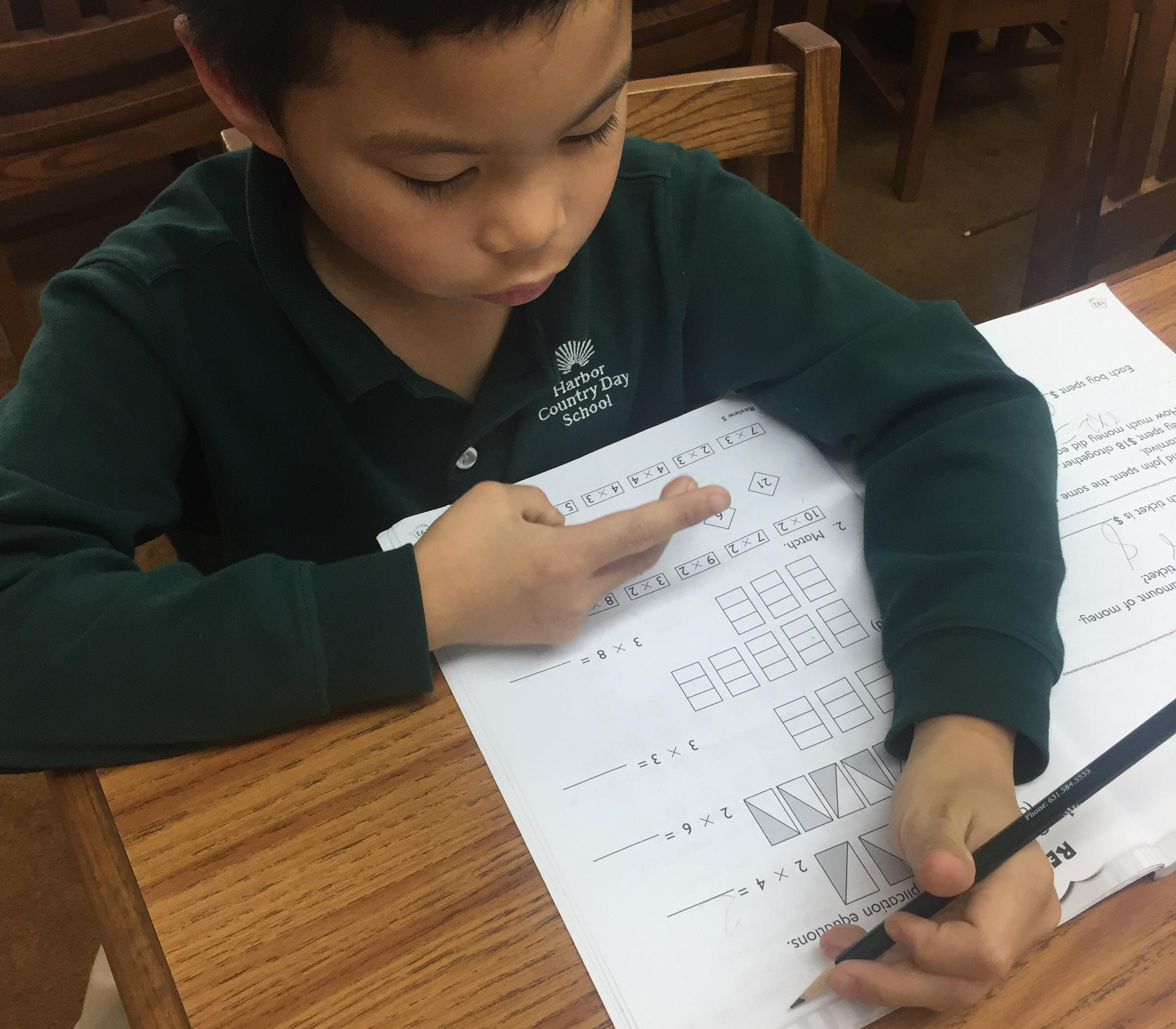

Units of study for Math include:
Addition and Subtraction with Renaming
Double and Triple Digit Numbers
Word Problems
Measuring Length
Metric and customary units
Multiplication and Division
0, 1, 2, 3, 4, 5, 10’s times tables
Money
Adding and subtracting
Fractions
Halves, fourths, thirds, and writing fractions
Telling Time
Tables and Graphs
Picture, bar, and line plots
Geometry
Flat and curved surfaces, composite figures, angles and shapes
Second Grade
SECOND GRADE SOCIAL STUDIES
Second grade social studies covers large themes to help students make sense of the world around them.


Social Studies themes include:
Governing People
Citizenship, leaders, community and state governments
The World Around Us
Maps and locations, North America, seasons and climate, world regions
Using our Resources
Land and water, people, changing our environment
People Long Ago
Early America, independence, American heritage, heroes and holidays
A World of Many People
World cultures, citizenship, celebrating culture
People in the Marketplace
Producers and consumers, work and income, from factory to you, barter and trade
Second Grade
THIRD GRADE LANGUAGE ARTS
The lower school English language arts program is based on the Reader’s and Writer’s Workshop model and draws heavily from the Teachers College Reading and Writing Project. In reading, our goal in third grade is to create an environment where students build on their love of reading. Exposing students to a range of genres provides the right context for this to happen. Students are no longer learning to read, they are reading to learn. Applying strategies to figure out unknown words; using clues in the text to improve comprehension; understanding characters, setting and plot; predicting what will happen next in a book; summarizing the big ideas in a story; and making personal connections to their reading are all skills developed in this grade.
Third graders publish a number of their own pieces that include creative writing, nonfiction writing, writing about reading, personal narratives, and poetry, culminating in an end-of-the-year lower school Book Festival. Students begin the year handwriting their published work and move into using technology for publishing. Cursive writing is also incorporated into our lessons in this grade. In addition, students are introduced to the basic concept of paragraph-writing. They learn the essential parts of a paragraph, which include main ideas, topic sentences, supporting and body sentences, and conclusions.
Learning about the mechanics of writing, such as capitalization, punctuation, and formatting, fine-tunes students’ work. Students come to appreciate the essential role revising their work plays in becoming great writers. Regular spelling tests help to build a broader vocabulary as well.
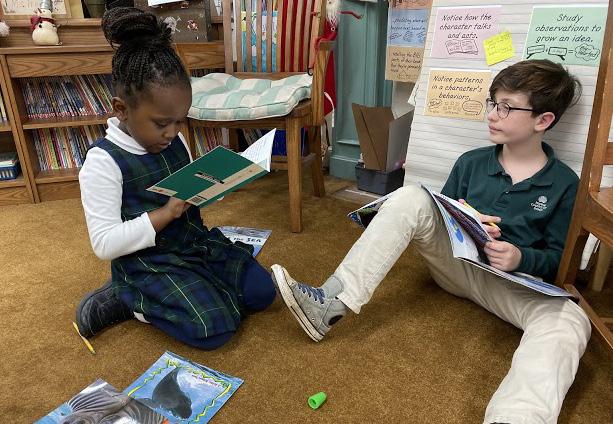

Reader’s and Writer’s
go hand-in-hand and include:
Personal Narratives
Realistic Fiction
Nonfiction
Roald Dahl Author Study
Poetry
Biography and Autobiography

Third Grade
THIRD GRADE MATH
Using the Singapore Math program, third grade math builds on the foundation laid in second grade.

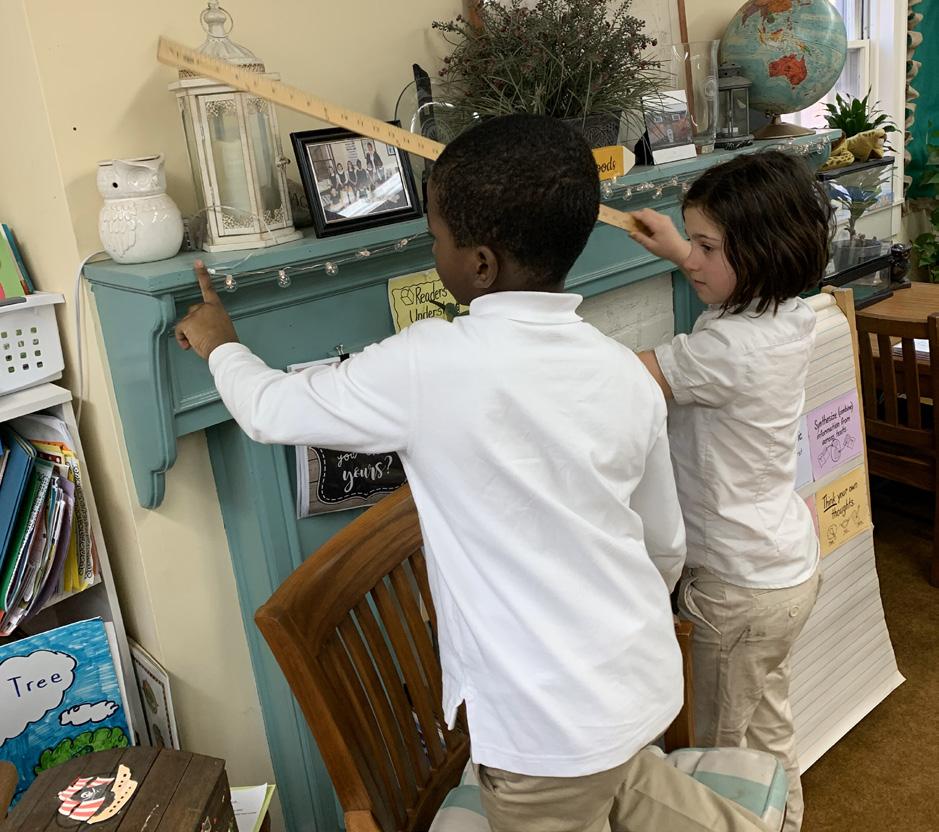
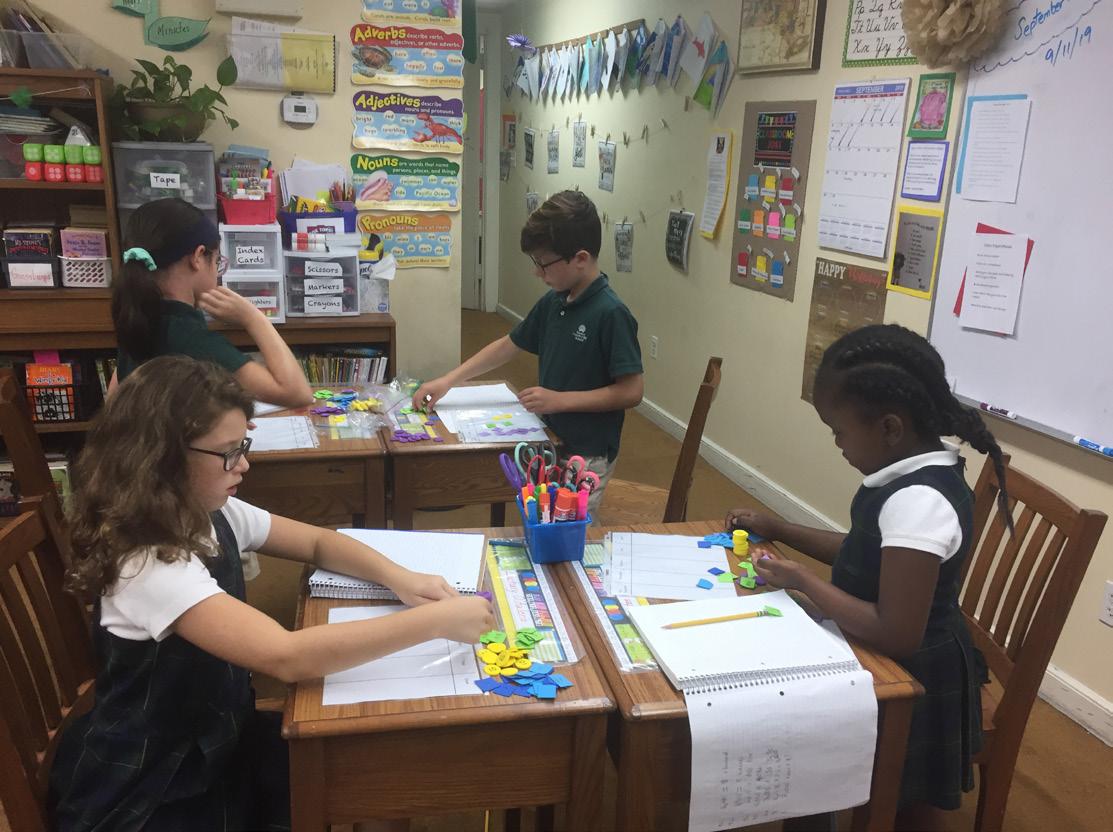
Concepts for Math include:
Addition and Subtraction with Renaming into the Thousands
Two-Step Word Problems
Multiplication and Division 6, 7, 8, 9, 10, 11, 12’s times tables
Length
Metric and customary, ex: meters, centimeters, kilometers, miles
Mass and Weight
Capacity
Liters, milliliters, cups, pints, quarts, gallons
Money
Adding and subtracting
Fractions
Equivalent fractions, fractions and measurement, fractions of a set
Telling Time
Data Analysis
Geometry
Right angles and shapes
Area and Perimeter
Composite Figures
Third Grade
THIRD GRADE SOCIAL STUDIES
Geography, how communities evolve, state and national government, and citizen’s rights in the United States are some of the big ideas we explore.
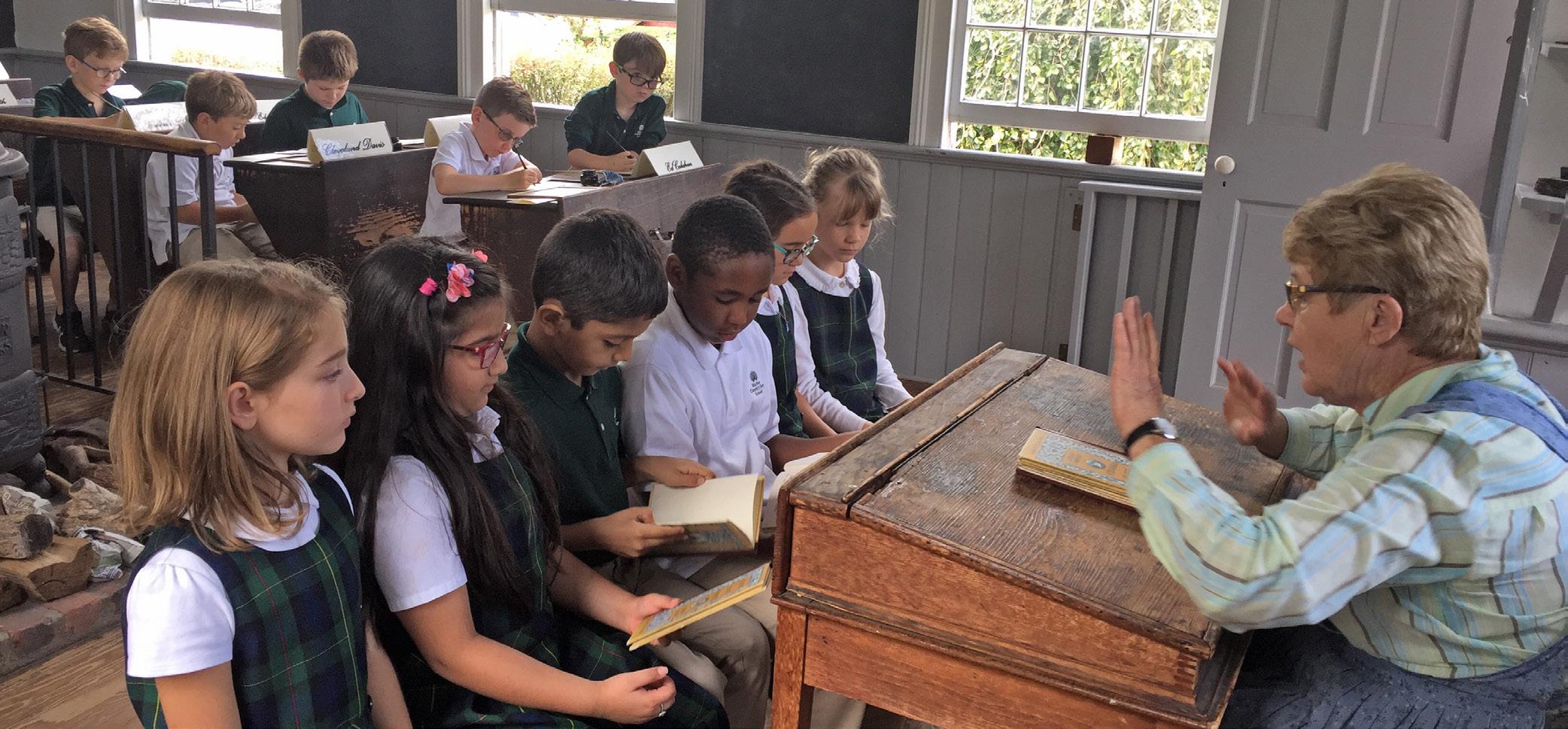



Social Studies units include:
Communities Around Us
Urban, suburban, rural
Communities and Geography
Latitude, longitude, landforms
Communities Over Time
Reading timelines, primary and secondary sources, first communities, growth and change Citizens and Government
Rights of citizens, structure of government, state and national governments, symbols of our nation, governments of our world
People in Communities
Moving to new places, American heritage, expressing and sharing culture, holidays and traditions
Working in Communities
Workers and consumers; new inventions; forms of money; earning, spending, and saving
Third Grade
FOURTH GRADE LANGUAGE ARTS
The lower school English language arts program is based on the Reader’s and Writer’s Workshop model and draws heavily from the Teachers College Reading and Writing Project. Continuing to build on the skills and approaches to reading in the earlier grades students meet in small book groups where they read, discuss, and write about a book that has been selected for their specific book group, based on the reading levels of the group’s members. They continue to read for enjoyment as well, supported by the teacher who helps them select books that are at the appropriate level and of a genre that each individual child will enjoy. Fourth grade writers examine the work of published authors, as well as their peers, which helps children apply the other authors’ techniques and integrate successful techniques into their own writing “voice.” Students continue to read for enjoyment, but also focus on studying the themes and authors’ intentions within increasingly challenging texts. We read like writers, and write like readers.
Students build a foundation of basic skills by learning how to write an essay with an introduction, supportive evidence, and a conclusion. Using the proper mechanics is expected.
Specific mini-lessons support students as they grow in their understanding and start to apply transition words, descriptive language, phrasing, and varied sentence structure. This allows students to further develop their own writer’s voice. Research is also a part of becoming capable readers and writers, as they find credible and varied sources and cite research.


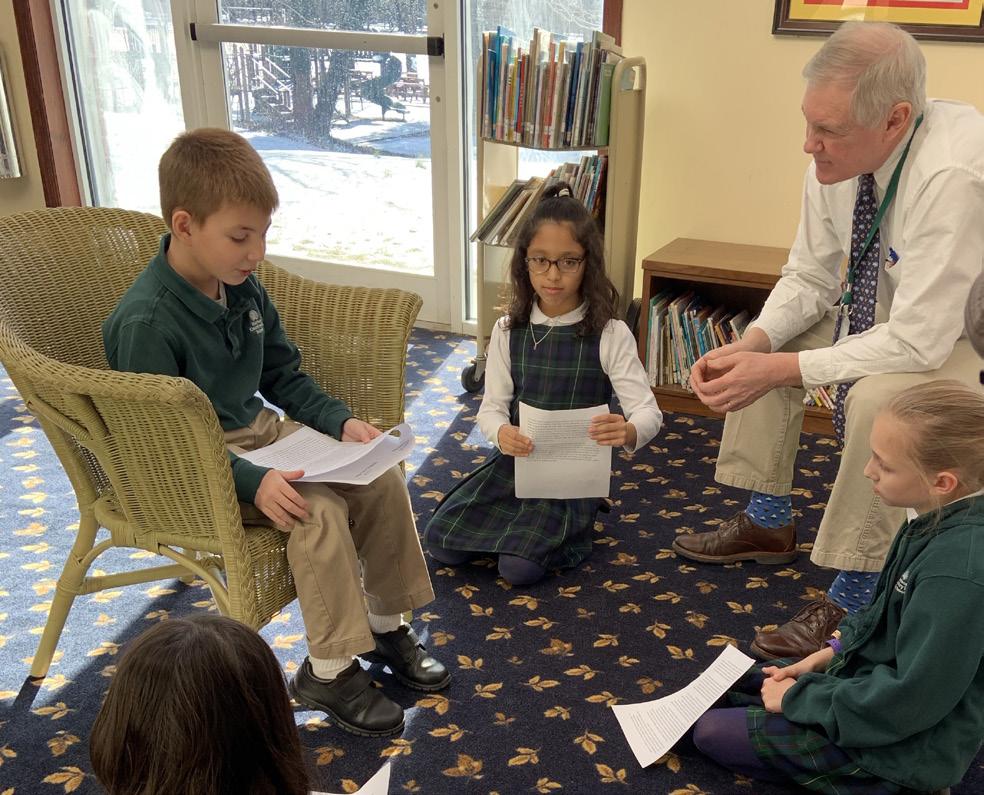
Units of study for Reader’s Workshop include:
Interpreting Characters
Weather Biographies
Historical Fiction
Poetry
Units of study for Writer’s Workshop include:
Persuasive Essays
Personal Essays
Informational Essays
Literary Essays
Realistic Fiction
Fourth Grade
FOURTH GRADE MATH
In fourth grade math, we continue to engage students
in a variety of new mathematical concepts and build their repertoire of problem-solving strategies. We look to help our young mathematicians strengthen their abstract reasoning, make sense of problems and persevere in solving them. We also guide students toward improving their application of appropriate and efficient strategies.



Concepts for Math include:
Familiarity with Factors and Multiples
Place Value Understanding and Properties of Operations (perform multi-digit arithmetic)
Extend Understanding of Fraction Equivalence and Ordering
Build Fractions from Unit Fractions by Applying and Extending Previous Understandings of Operations on Whole Numbers
Understand Decimal Notation for Fractions, and Compare Decimal Fractions
Solve Problems Involving Measurement and Conversion of Measurements
Represent and Interpret Data
Geometric Measurement: Understand Concepts of Angles and Measure Angles
Fourth Grade
FOURTH GRADE SOCIAL STUDIES
The theme of the fourth grade social studies program is the state of New York, focusing heavily on Native Americans, Colonial America, the Revolutionary War and immigration. There are many ways in which the concepts in social studies are reinforced, including the Wax Museum project, one of the central projects of the year, in which students are asked to study an individual from American history and portray that individual for visitors to the “Wax Museum” on a designated day. This unit culminates in a day class trip to Ellis Island. The fourth grade School Store, wherein students create their own handmade, personal goods for sale, price them appropriately, and sell their goods to others when the store is “open,” has also become a tradition where students learn about the concepts of trade and commerce. Parents are invited to these events throughout the year.



Fourth Grade
FIFTH GRADE ENGLISH
In fifth grade English, we continue to use the Reader’s and Writer’s workshop model.
In Reader’s Workshop we use a wide-range of texts to support critical and analytical thinking about characters and how they influence the theme(s) of the story. Some texts are read aloud by the teacher to the whole class, and the teacher facilitates rich discussions. Some texts are read in small groups (Book Clubs) and the discussions are student-led. Independent reading occurs both in class and at home (similar to previous grades); students choose which books they are interested in reading, making sure they are choosing books that are appropriate in content, are of high interest, and that they are able to comprehend on their own. The teacher meets with each child routinely and engages in one-on-one conferences. This individualized attention allows teachers to get to know each student and differentiate the level of instruction. Writing about reading is a major component of Reader’s Workshop as well. Children continuously build on their thinking about texts through written responses in their Reader’s Notebooks. Making predictions about where the story will lead, inferring elements of the story, making personal connections to passages, and examining the themes of a book are some of the ways students will respond to a text as writers.
Students make increasingly sophisticated choices about their writing. The habits our readers and writers develop and the skills they are taught are transferred to other areas of the curriculum, emphasizing that sophisticated, effective, clear, thoughtful communication takes place in all classes. Students also build their vocabulary, looking at root words, base words, and Greek and Latin roots. Students are exposed to a variety of writing styles by looking at the work of other authors. Children learn specific self-revision and peer revision techniques so that they are able to share their ideas effectively with one another and give kind, specific, and helpful feedback. Following both peer conferences and teacher conferences, students proofread, edit, and publish their own work. Mechanics, grammar, spelling, and vocabulary play increasingly important roles as students become more aware of how these elements impact their writing and their ability to express themselves clearly, effectively, and with growing confidence.

Reader’s Workshop units include:
Analyzing Themes
Argument and Advocacy: Debatable Issues
Poetry
Fantasy Book Clubs
Egyptian Study Research Project
Personal Narrative
Writer’s Workshop units include:
Personal Narrative
Small Moment
Flash Fiction
Poetry
Argument and Advocacy: Debatable Issues
Egyptian Study Research Project
Persona/Point-of-View
Literary Essays
Fifth Grade
FIFTH GRADE MATH
Continuing with Singapore Math , students build on the familiar skills and concepts
learned in previous grades. They are also introduced to new concepts. In addition to Singapore Math, supplemental materials and strategies are also used to prepare students for mathematics in the upper school, as fifth grade is the last year the Singapore Math program is taught.


In fifth grade, mathematics includes:
Addition and Subtraction of Fractions
Developing an Understanding of the Multiplication of Fractions and the Division of Fractions
Extending Division to Two-Digit Divisors
Integrating Decimal Fractions into the Place Value System
Developing Understanding of Operations with Decimals to the Hundredths Place
Developing Understanding of Volume, Area, and Perimeter
Ratios
Fifth Grade
FIFTH GRADE SOCIAL STUDIES
In fifth grade, small group work, rich discussions, hands-on activities, and independent work create opportunities for children to collaborate, reflect, and deepen their understanding of history’s impact on our world, our way of being today, and our role in writing the history of tomorrow. The fifth grade history curriculum begins with a review and study of world geography. We carefully consider how geography plays a major role in the lives of people. This sets the stage as we move into the Stone Age, the transition from the Paleolithic Era to the Neolithic Era, and the effect of Homo sapiens on modern society. Next, we move into an in-depth study of early civilizations and our expanded, project-based study of Ancient Egypt where students learn about the gods, goddesses, and pharaohs that existed at this time. This unit culminates in the re-creation of the mummification and burial processes by dissecting and mummifying fetal pigs, creating tombs for the pigs, and hosting a celebration of the installation of their own mummified pharaohs. We end our school year investigating Ancient Greece in a unit that integrates history and English.



FIFTH GRADE
TECHNOLOGY
In fifth grade technology, students learn about advanced coding and develop their robotics skills using tools such as Scratch and Lego Mindstorms EV3’s. Students work independently using Scratch lesson cards to learn new coding techniques. In the process, students devise their own coding projects, which allows them to create something about which they are passionate. Students build robots, code them, and guide the robots through an obstacle course with the use of motors and sensors. All of this work is accomplished through hard work, resilience, and collaboration with their peers and the teacher.
CO-CURRICULARS
Co-curricular teachers not only teach each discipline as its own class, they also work with classroom teachers
ARTThe Harbor Country Day School studio art program is designed to help students grow in knowledge, perception, and appreciation of the arts. We help children grow in these areas by
exposing them to the theory and practice of art. Experimenting with new materials, exploring ways of creating, and discovering new ideas are just as important as the history behind why we are able to create art today. The study of art history is an integral component to the curriculum, becoming the springboard for many projects. Students become well-versed in expressing their creative thoughts through the study of art studio vocabulary and group critiques. Students share their strengths/weaknesses and failures/successes while discussing their work and the work of others. A safe and open environment is fostered by never giving up, keeping an open mind, learning from our mistakes, and understanding that artists are problem-solvers. and integrate their practice into the academic curriculum. We believe this relationship is essential. Students learn that subject matter is not discrete; rather, it is interwoven throughout life both inside and outside of school and across disciplines.



Art Theories/Practices Explored:
Elements of Art
Principles of Design
Printmaking
Clay
Drawing
Painting
Illustration
Organic/Geometric Shapes
Emotion/Expression through Creating
Group Critiques
Color Theory
Art History
Collage
Collaboration
Cultural Explorations
Lower School Co-Curriculars
MUSIC
First through fifth grade music has several
components that provide students with a well-rounded foundation, understanding, and appreciation of music.


Components of our program include:
Music Theory
• Note Reading on the Treble Clef
• Rhythms Including Whole, Half, Eighth, and Sixteenth Notes
Chorus
• One Chorus Rehearsal Per Week
• Two Concerts Per Year
Instrumental Music — first, second and third grade, which includes but is not limited to the study of:
• Glockenspiel
• Flutophone
• Ukulele
• Recorder
• Various Percussion Instruments
• Keyboard Instruments
Instrumental Music — fourth grade
• Band Instrument
• Spring Band Concert
Music Theory — fifth grade
• Note Reading on the Bass Clef
• Addition of Compound Rhythms
• Major and Minor Scales
• Music Composition
Music History — fifth grade, which covers the following time periods:
• Medieval
• Renaissance
• Baroque
• Classical
• Romantic Band — fifth grade
• One Instrument-Specific Lesson Period
• Two Band Rehearsals with the Upper School Band Per Week
• Two Band Concerts Per Year
Chorus
• Two Rehearsal Periods with the Upper School Chorus Per Week
• Two Choral Concerts Per Year

Lower School Co-Curriculars
PHYSICAL EDUCATION
We value physical education (PE) and consider it an essential part of
our curriculum. Learning how to work together and be a member of a team, sportsmanship, and being exposed to a variety of activities helps students grow into healthy, joyous, well-rounded individuals, capable of making choices that benefit themselves as well as a group.



First Grade
The first grade physical education curriculum continues to build on the foundational skills and team-building work that begins in preschool and kindergarten. Some key components of the first grade physical education curriculum are:
Safety (moving with others in a big space/ using PE equipment appropriately)
Movement Exploration
Developing/Reinforcing Locomotor Skills
Practicing Motor Skills/Pathways
Developing Eye/Hand and Eye/Foot
Coordination Skills
Social Interaction
Introduction to Basic Sport Skills
Second through Fourth Grade
Physical education classes in this age group focus on exhibiting good sportsmanship and learning to work together as a team. Our goal is for our students to develop a love of movement at a young age, so they will value physical activity for the rest of their lives. We look to help students:
Demonstrate competency in motor skills and movement patterns needed to perform a physical activity
Demonstrate understanding of movement concepts, principles, and strategies
Focus on sportsmanship, teamwork, and leadership while learning strategies of a game
Begin to take part in structured sport activities
Some units that students in first through fourth grade take part in throughout the school year are:
Soccer
Cooperative Games/Team Building
Basketball
Scooter Basketball
Fitness Stations
Tag Games
Use of Scooters
Jump Rope
Kickball
Lower School Co-Curriculars
PHYSICAL EDUCATION
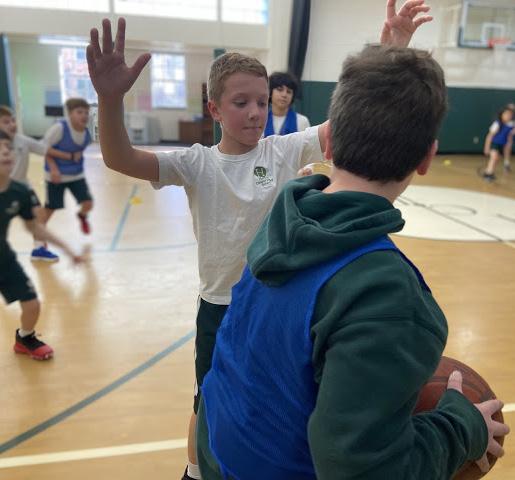
Fifth Grade
Being that this is considered our “bridge year,” a strong emphasis on communication, teamwork and sportsmanship is a major component of each class as students begin to represent the Harbor Hawks during interscholastic sporting events. Students at this age take part in both soccer and basketball, where their PE classes are designed in a practice-like fashion and build on the various skills needed to help them successfully compete against other schools. In fifth grade, we look to help students:
Demonstrate an understanding of rules and regulations of various sports
Understand healthy ways to communicate and deliver information through physical activity
Challenge themselves in a safe and monitored environment
When students are not in season with soccer or basketball, they take part in more competitively formed units of:
European Handball
Cooperative Games
Fitness Stations
Non-Traditional Bowling
Tennis/Volleyball
Scooter Basketball/Hockey
Lower School Co-Curriculars
SCIENCE
Lower school science is a time for exploration and discovery. Students study aspects of biological, earth, and physical sciences with the early childhood/
lower school science specialist. They are encouraged to visualize themselves as scientists as they develop science skills including observing, classifying, predicting, recording data, and drawing conclusions. They are introduced to the scientific method through inquiry-based activities and lab experiences. They challenge themselves and persevere in solving complex questions through various STEAM activities.
First Grade
Units of Study: Waves—Light and Sound, Structure/Function/Information Processing, Space Systems: Patterns and Cycles
Highlights: “Your Genetic Traits” field trip at Long Island Science Center, seining field trip to Asharoken Beach in Northport for aquatic organisms
Second Grade
Units of Study: Structure and Properties of Matter, Interdependent Relationships in Ecosystems, Earth’s Systems: Processes that Shape the Earth
Highlights: The Rock Cycle program at Long Island Science Center, Whale of Wonders
Third Grade
Units of Study: Forces and Interactions, Interdependent Relationships in Ecosystems, Inheritance and Variation of Traits: Life Cycles and Traits, Weather and Climate
Highlights: Field Trip to BB&GG Nursery for Plant Identification and Classification, Long Island Aquarium
Fourth Grade
Units of Study: Energy, Waves: Waves and Information, Structure, Function, Information Processing, Earth’s Systems: Processes that Shape the Earth
Highlights: Storm Water Superheroes Program, Electricity & Magnets Program at Long Island Science Center
Fifth Grade
Fifth grade students will explore the life, physical and earth sciences in a lab-based setting as part of our lower school to upper school bridge model. The scientific process forms the backbone of our laboratory work, and lab reports are the culmination of the students’ research and handson studies. Basic academic skills, such as notetaking, proper lab report writing, discussion, and collaboration, are reinforced throughout the year.
Units of Study: Structure and Properties of Matter, Matter and Energy in Organisms and Ecosystems, Earth’s Systems, Space Systems: Stars and the Solar System
Highlights: “A Day in the Life of the Nissequogue River” Trip, Magical Molecules Program at Long Island Science Center

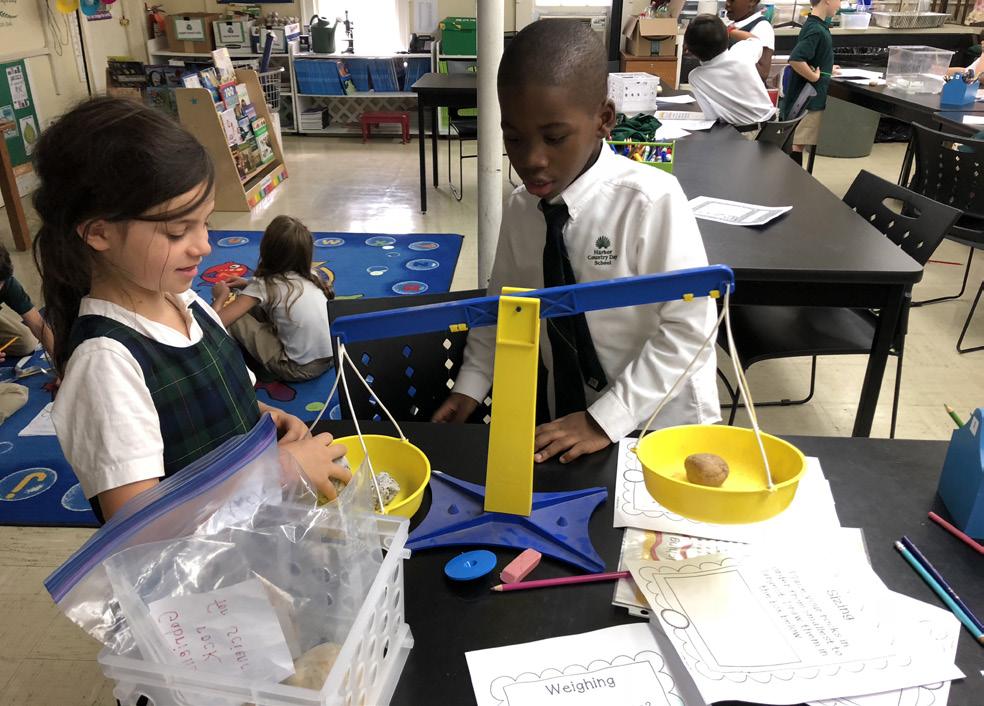
Lower School Co-Curriculars
LIBRARY AND MAKER SPACE
The library curriculum is designed to foster
a love of reading, develop an appreciation of literature, support the classroom curriculum, and create an understanding of research techniques, as well as teach the children how to use the library catalogue to find books and online sources. Within the library, the MakerSpace allows students to use new and different materials to explore, create, and build based on their individual interests. In the MakerSpace, students can work independently or collaborate in small groups.
TECHNOLOGY (First - Fourth Grade)
The lower school technology program is designed to develop a technical repertoire of computer skills for the 21st century. Students learn how to use technology safely and responsibly and are taught the specific skills needed to use different applications on the computer.
STEAM
STEAM is a philosophy of teaching that incorporates multiple disciplines through student-centered, inquiry-based projects that develop real-world skills. We created
a process that is easy for children to understand, and will guide students in the “design thinking” problemsolving methods when creating their STEAM projects. It provides a framework and direction for students to create solutions to the problems they are trying to solve. The process is:
Observe – Focus – Design – Create – Share
Our STEAM program delivers educational experiences through inquiry-based projects that integrate S cience, T echnology, E ngineering, A rt, and M ath exploration. Through STEAM, students learn how to seek solutions and answers to questions we face in our community and our world. The STEAM curriculum changes each year based on the different interests of the students and the challenges they choose to address through the STEAM program.
The STEAM design team of teachers meets weekly and teaches as a team in the lower school throughout the year. The projects are derived from the students with the teachers guiding them throughout the entire creative process that follows the STEAM philosophy. One example of a successful year-long project was the fourth graders who recognized their desire to help animals and discovered a need at a local nature center, SweetBriar, that was in need of bird feeders. They followed the framework of STEAM projects and presented their completed feeders to the nature center at the end of the year. Each year, the projects are different and based upon the brainstorming of the different grade’s ideas to help our local community.


Lower School Co-Curriculars
FOREIGN LANGUAGE
Our robust foreign language program incorporates listening,
speaking, reading, and writing in either Mandarin or Spanish, as well as the in-depth study and celebration of the cultures related to those languages. In the lower school, children study both Mandarin and Spanish. Starting in fifth grade, students choose one language on which to focus, which carries through eighth grade.
MANDARIN
First and Second Grade
Mandarin is taught verbally through movies, movement, songs, literature, and simple games. Children are introduced to new vocabulary in a variety of engaging activities and at their own pace. Students also create crafts and artifacts from Chinese culture to broaden their exposure to the country of China.
First grade vocabulary and skills include:
• Basic Greetings
• Colors
• Numbers 1-30
• Family Members
• Fruits
• Several Pinyin Songs
Second grade vocabulary and skills include:
• Basic Greetings
• Colors
• Numbers 1-100
• Family Members
• Fruits
• Body Parts
• The Chinese Zodiac and Animals
• The Four Seasons
• The 23 Initials and 24 Finals of Pinyin
Lower School Co-Curriculars
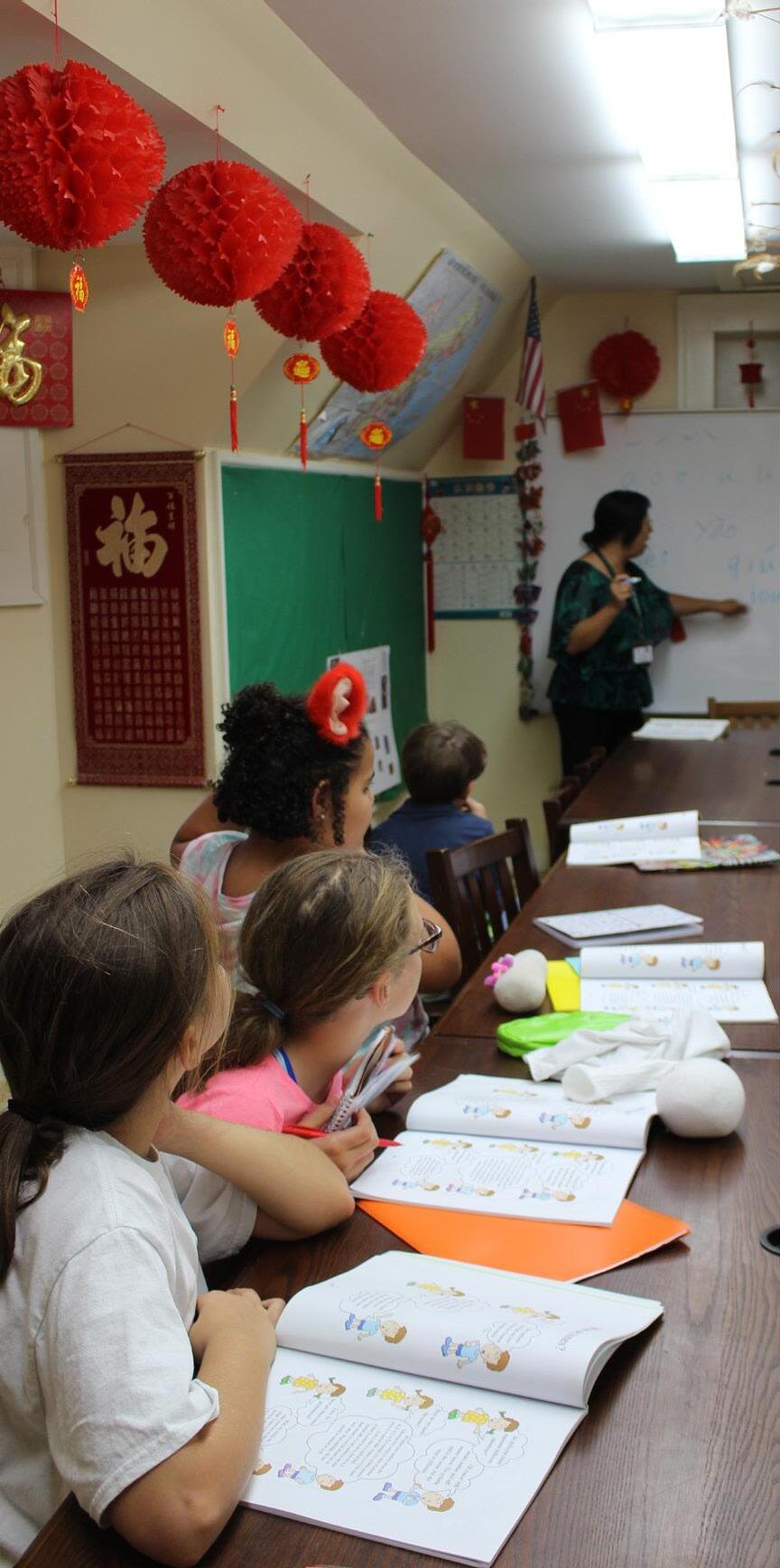
Third Grade and Fourth Grade
Students continue to build their skills in speaking, listening, reading, and writing. Vocabulary is reinforced consistently through the use of videos, songs, games, and storytelling. Students review and learn new vocabulary as well.
Third grade vocabulary and skills include:
• Basic Greetings
• Colors
• Numbers 1-500
• Family Members
• Fruits
• Body Parts
• The Chinese Zodiac and Animals
• The Four Seasons
• The 23 Initials, 24 Finals, and 4 Tones of Pinyin
• Telling Time
Fourth grade vocabulary and skills include:
• Basic Greetings
• Colors
• Numbers 1-1,000
• Family Members
• Fruits
• Body Parts
• The Chinese Zodiac and Animals
• The Four Seasons
• Weather
• The 23 Initials, 24 Finals, and 4 Tones of Pinyin
• Telling Time
• Calendar Dates
FOREIGN LANGUAGE
MANDARIN
Fifth Grade
Students continue to develop the four language skills: listening, speaking, reading, and writing. In fifth grade, there is a greater emphasis on reading and writing. Through the ongoing acquisition of vocabulary and grammar, students are immersed in everyday situations. The Mandarin program is designed not only to build language skills, but also the social knowledge required to communicate meaningfully and effectively, setting students on a path to strong language acquisition in high school and beyond. Cultural study is magnified by engaging projects and group discussions throughout the year.


Fifth grade vocabulary and skills include:
• Basic Greetings
• Colors
• Numbers 1-10,000
• Family Members
• Fruits
• Body Parts
• The Chinese Zodiac and Animals
• The Four Seasons
• Weather
Lower School Co-Curriculars
• The 23 Initials, 24 Finals, and 4 Tones of Pinyin
• Telling Time
• Calendar Dates
• The 18 Basic Chinese Radicals and 12 Writing Rules
• Basic Writing
• Chinese Currency
• Geography of China
FOREIGN LANGUAGE
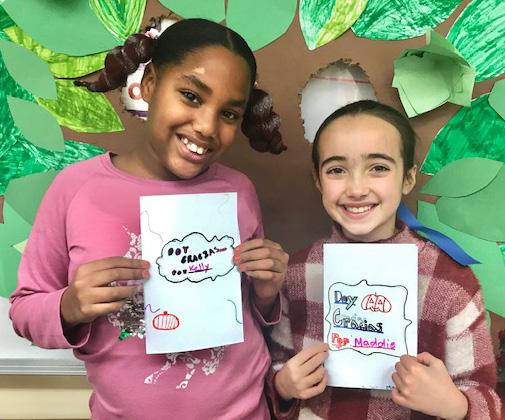

SPANISH
First Grade
First grade Spanish is taught verbally through movement, songs, literature, and simple games. Children are introduced to new vocabulary in a variety of ways and at their own pace. Students learn greetings and introductions using the target language. They respond well to their names in Spanish and recognize numbers from 1-30, colors, and a few simple commands. We also use the Symtalk approach for language learning in the classroom. This method involves the recognition of symbols and their meanings, which allows students to interact directly with the language and play along as they form simple sentences.
First grade themes include:
• Greetings
• Numbers 1-20
• Basic Commands
• Farm Animals
• Family Members
• Colors
Second Grade
In second grade, Spanish continues to be taught verbally through movement, songs, literature, and simple games. We also use Muzzy and His Friends as a resource for this grade. Students are introduced to the written word and begin to recognize frequently used words.
Second grade themes include:
• Greetings
• Colors
• Numbers 1-50
• Body Parts
• Fruits
• Prepositions of Place
• Adjectives
• Domestic Animals
• Food-Related Vocabulary
Third and Fourth Grade
Students continue to build their speaking, listening, reading, and writing skills. Vocabulary is consistently reinforced through the use of videos, songs, games, and storytelling. Students review and learn new vocabulary as well.
Third and fourth grade themes include:
• Greetings
• Colors
• Numbers 1-100
• The Alphabet
• Body Parts
• Action Commands
• School Related Vocabulary
• Rooms of the House
• Family Members
• Simple Math Functions
• Occupations
• Days and Months
• Weather
• Seasons

Lower School Co-Curriculars
FOREIGN LANGUAGE
SPANISH
Fifth Grade
In fifth grade, students begin to explore the Spanish language more deeply. There is a greater emphasis on reading and writing. Culture is an important addition to the curriculum. Students enjoy learning about customs and traditions and bring their creative talents to a number of projects throughout the year.

Lower School Co-Curriculars

Fifth grade themes include:
• Greetings
• The Alphabet
• Math Functions
• Numbers 1-1000
• Geography of Spain and Mexico
• Classroom Objects
• Commands
• Family
• Food
• Animals
• Body and Health
• Weather and Seasons
• Time
• Colors
